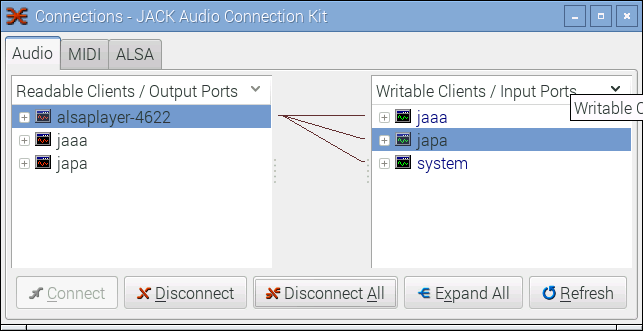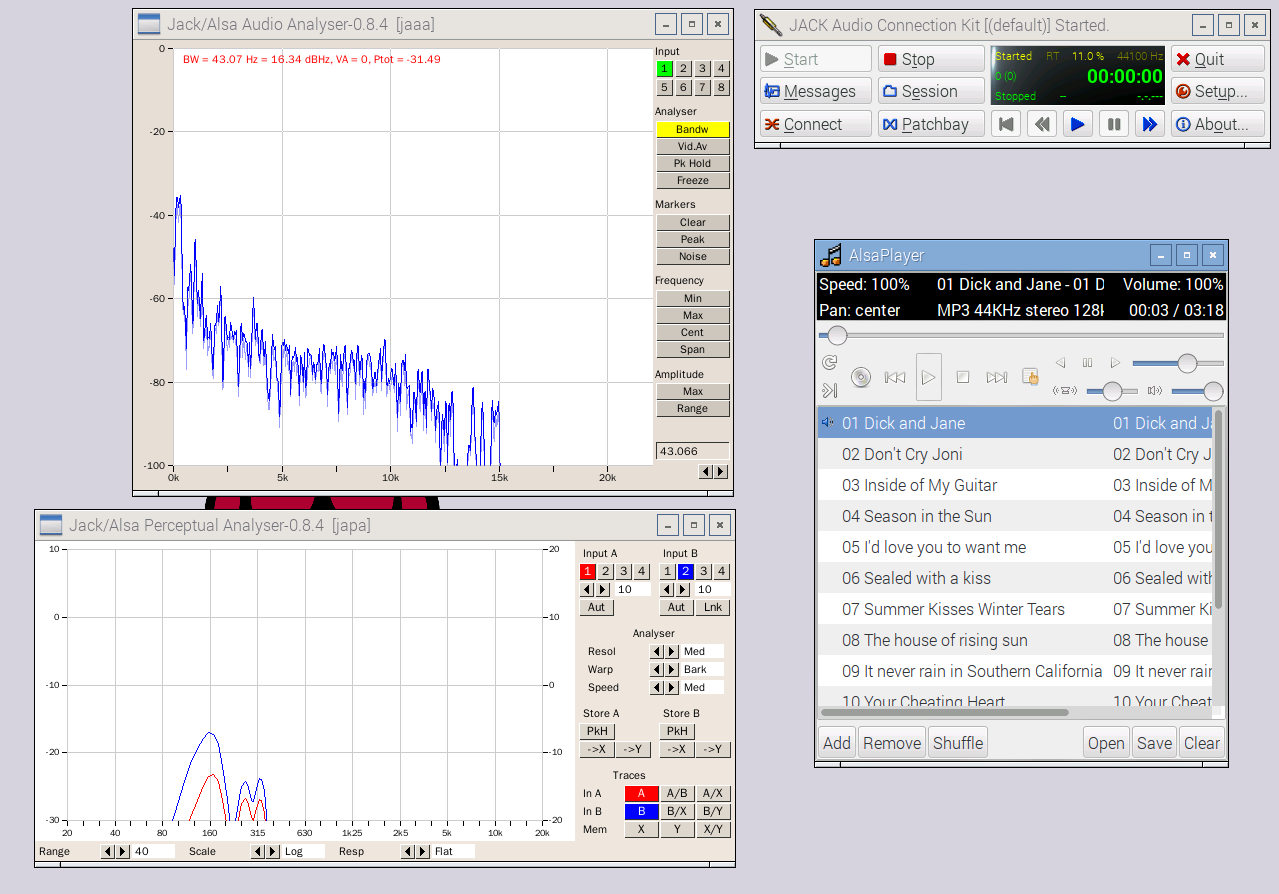過去當人們走過街角之書店,偶然地發現一本吸引人的書,也許會駐足翻閱一番,再決定是否要沉浸於書中的奇異世界。而今人們在網際網路的汪洋裡打撈,篩選過濾無所不在的廣告。曾幾何時世界變成了喧囂的市場?或許因此知覺也早就超載的了!模糊的記憶,想不出如何邂逅上
japa
The JACK & ALSA Audio Perceptual Analyser, is a ‘perceptual’ or ‘psychoacoustic’ audio spectrum analyser.
In contrast to JAAA, this is more an acoustical or musical tool than a purely technical one. Possible uses include spectrum monitoring while mixing or mastering, evaluation of ambient noise, and (using pink noise), equalisation of PA systems.
,一個所謂的『聲音』『知覺』分析儀。依稀記得當初為了弄明白它的『名目』,在大海裡撈針。很高興發現了一篇『通告』︰
JAPA Jack/Alsa Perceptual Analyser initial release
| From: | fons adriaensen <fons.adriaensen-AT-skynet.be> | |
| To: | Linix Audio Developers <linux-audio-dev-AT-music.columbia.edu>, Linux Audio Announce <linux-audio-announce-AT-music.columbia.edu>, JACK Developers <jackit-devel-AT-lists.sourceforge.net> | |
| Subject: | [linux-audio-announce] [ANN] JAPA Jack/Alsa Perceptual Analyser | |
| Date: | Sat, 6 Aug 2005 17:24:17 +0200 |
The first (alpha) release of JAPA is now available at
<http://users.skynet.be/solaris/linuxaudio>>
>From the README:
JAPA is a ‘perceptual’ or ‘psychoacoustic’ audio spectrum
analyser. This means that the filters that are used to
analyse the spectrum have bandwidths that are neither
constant (as in JAAA), nor proportional to the center
frequency (as in a 1/3 octave band analyser), but tuned
to human perception. With the default settings, JAPA uses
a filter set that closely follows the Bark scale.
In contrast to JAAA, this is more an acoustical or musical
tool than a purely technical one. Possible uses include
spectrum monitoring while mixing or mastering, evaluation
of ambient noise, and (using pink noise), equalisation
of PA systems.
JAPA allows you to measure two inputs at the same time,
compare them, store them to memory and compare them to
stored traces. It offers a number of resolutions, speeds,
and various display options. The dual inputs and memories
will find their way into future JAAA versions as well.
This is a source release. You will also need libclalsadrv,
libclthreads (from the same place), and libfftw3f.
Enjoy !
—
FA
,卻失笑於那個『讀我』 README 之文。畢竟難得天真如愛麗絲,看到『吃我』就『吃』,『喝我』就『喝』的吧!終究那個
Bark scale
The Bark scale is a psychoacoustical scale proposed by Eberhard Zwicker in 1961. It is named after Heinrich Barkhausen who proposed the first subjective measurements of loudness.[1]One definition of the term is “…a frequency scale on which equal distances correspond with perceptually equal distances. Above about 500 Hz this scale is more or less equal to a logarithmic frequency axis. Below 500 Hz the Bark scale becomes more and more linear.”[2]
The scale ranges from 1 to 24 and corresponds to the first 24 critical bands of hearing. [3]
It is related to, but somewhat less popular than[citation needed], the mel scale, a perceptual scale of pitches judged by listeners to be equal in distance from one another.
Bark scale critical bands
| Number | Center Frequency (Hz) | Cut-off Frequency (Hz) | Bandwidth (Hz) |
|---|---|---|---|
| 20 | |||
| 1 | 60 | 100 | 80 |
| 2 | 150 | 200 | 100 |
| 3 | 250 | 300 | 100 |
| 4 | 350 | 400 | 100 |
| 5 | 450 | 510 | 110 |
| 6 | 570 | 630 | 120 |
| 7 | 700 | 770 | 140 |
| 8 | 840 | 920 | 150 |
| 9 | 1000 | 1080 | 160 |
| 10 | 1170 | 1270 | 190 |
| 11 | 1370 | 1480 | 210 |
| 12 | 1600 | 1720 | 240 |
| 13 | 1850 | 2000 | 280 |
| 14 | 2150 | 2320 | 320 |
| 15 | 2500 | 2700 | 380 |
| 16 | 2900 | 3150 | 450 |
| 17 | 3400 | 3700 | 550 |
| 18 | 4000 | 4400 | 700 |
| 19 | 4800 | 5300 | 900 |
| 20 | 5800 | 6400 | 1100 |
| 21 | 7000 | 7700 | 1300 |
| 22 | 8500 | 9500 | 1800 |
| 23 | 10500 | 12000 | 2500 |
| 24 | 13500 | 15500 | 3500 |
Since the direct measurements of the critical bands are subject to error, the values in this table have been generously rounded.[1]
In his letter “Subdivision of the Audible Frequency Range into Critical Bands”, Zwicker states:
“These bands have been directly measured in experiments on the threshold for complex sounds, on masking, on the perception of phase, and most often on the loudness of complex sounds. In all these phenomena, the critical band seems to play an important role. It must be pointed out that the measurements taken so far indicate that the critical bands have a certain width, but that their position on the frequency scale is not fixed; rather, the position can be changed continuously, perhaps by the ear itself.”
Thus the important attribute of the Bark scale is the width of the critical band at any given frequency, not the exact values of the edges or centers of any band.
,使我知道了這個軟體的設計由來,引領我思考『主觀』『知覺』的現象。驚訝於『濾波』與『忽略』無所不在之『聽覺』?竟可能是『音樂』和『語言』得以『存在』的基礎??如果人類具有沒有極限之『聲音分辨力』,也許只能像是個超級『頻譜分析儀』,徒有『超量之數據』又該如何談『相似』以及『分類』的呢??!!
或許一小段維基百科的詞條文本︰
心理聲學
心理聲學(Psychoacoustics)是研究人對聲音感知的學科,即研究人對聲音(包括言語和音樂)的生理和心理反應的科學,是心理物理學的分支學科。
背景
聽覺不完全是波的力學現象。聲音是一種機械波,通過空氣傳播到人耳,在人耳中轉變為神經動作電位,神經脈衝到達大腦,人感知到聲音。因此,在很多聲學問題中,比如音頻信號處理,需要考慮聽覺體驗中人的耳朵和大腦的作用。比如,內耳在把聲音波形轉化為神經刺激的過程中起著重要作用,有些波形的差別可能無法被感知到。[1] 這一知識可以應用到數據壓縮技術,比如MP3。[2] 人耳對不同強度的聲音的響應是非線性的,這種非線性的響應叫做響度。電話網絡和音頻降噪系統利用這一事實,先對數據樣本進行非線性壓縮,然後再傳遞數據,然後在接收端解壓縮,播放聲音。[3]
Psychoacoustics
Psychoacoustics is the scientific study of sound perception. More specifically, it is the branch of science studying the psychological and physiological responses associated with sound (including speech and music). It can be further categorized as a branch of psychophysics.
Background
Hearing is not a purely mechanical phenomenon of wave propagation, but is also a sensory and perceptual event; in other words, when a person hears something, that something arrives at the ear as a mechanical sound wave traveling through the air, but within the ear it is transformed into neural action potentials. These nerve pulses then travel to the brain where they are perceived. Hence, in many problems in acoustics, such as for audio processing, it is advantageous to take into account not just the mechanics of the environment, but also the fact that both the ear and the brain are involved in a person’s listening experience.
The inner ear, for example, does significant signal processing in converting sound waveforms into neural stimuli, so certain differences between waveforms may be imperceptible.[1] Data compression techniques, such as MP3, make use of this fact.[2] In addition, the ear has a nonlinear response to sounds of different intensity levels; this nonlinear response is called loudness. Telephone networks and audio noise reduction systems make use of this fact by nonlinearly compressing data samples before transmission, and then expanding them for playback.[3] Another effect of the ear’s nonlinear response is that sounds that are close in frequency produce phantom beat notes, or intermodulation distortion products.[4]
The term “psychoacoustics” also arises in discussions about cognitive psychology and the effects that personal expectations, prejudices, and predispositions may have on listeners’ relative evaluations and comparisons of sonic aesthetics and acuity and on listeners’ varying determinations about the relative qualities of various musical instruments and performers. The expression that one “hears what one wants (or expects) to hear” may pertain in such discussions.
,有助於我們了解這門科學的旨趣。實際上的『體驗』,或將啟發我們探索『聽覺』之奧秘耶!!??
【 AlsaPlayer ︰ JACK mp3 播放器】
【將之連接兩種頻譜分析儀】
【觀察】


